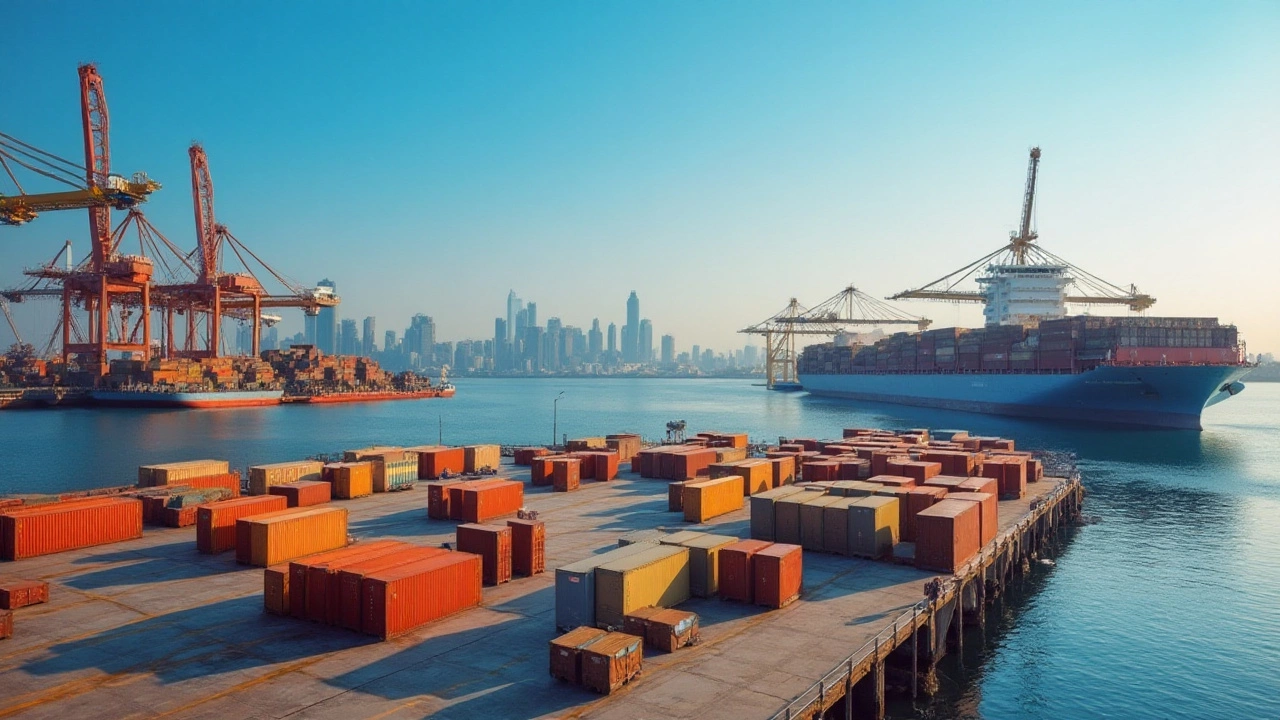Sending something halfway across the world isn't just a click away; there's a lot more to it than hitting 'send.' Ever wondered why transporting your goods internationally sometimes feels like deciphering a complicated puzzle? That's because shipping across borders involves an array of factors, each influencing the final bill differently.
From how far your package's destination is to how quickly you want it there, the costs can shift dramatically. Let's unravel the secrets behind these numbers, giving you a clear roadmap for your next overseas delivery.
- Understanding Shipping Costs
- Factors Affecting Prices
- Choosing the Right Service
- Tips for Cost-Effective Shipping
Understanding Shipping Costs
Imagine standing in line at the post office, package in hand, pondering the question: just how much will it cost to send this thing to the other side of the globe? You're not alone. The cost of sending packages overseas can be a head-scratcher if you're not familiar with the various components that make up the pricing structure. It's not as simple as slapping a stamp on it and sending it off. A thorough understanding of how these costs break down can both prepare you for the inevitable expenses and potentially save you some cash.
One essential part of the cost is the distance the package needs to travel. It's intuitive—your parcel's journey from Toronto to Tokyo, for instance, is quite the trek. Major shipping companies often calculate their fees based on 'zones' determined by distance. And let me tell you, each zone jump can put a chunk on your bill. But distance isn't the only factor at play. Weight plays a critical role in determining costs too. Whether you're sending hand-knitted scarves or a box of books, understanding the weight group's specifics can help you anticipate expenses appropriately.
A study from the International Transport Forum highlights that "global logistics costs can be reduced by as much as 10-30% by optimizing transportation and consolidating shipments."
Next up is the size of your package—something people tend to overlook until they're at the counter with a too-big box in hand. Carriers often use a calculation called dimensional weight, combining size and weight, to determine the rate. Smaller but heavier items might cost less than lighter yet bulkier ones. Additionally, delivery speed—the time period within which you want your package to arrive—significantly impacts the cost. Economy, priority, and express options offer different windows, priced accordingly.
Then there are the hidden costs you'll want to watch out for. Taxes and duties can surprise you at the last minute based on the value of your shipment and the regulations of the destination country. Don't forget the potential fees for insurance, which may be worth considering if your package is valuable or fragile. Certain carriers also add surcharges for fuel or remote area deliveries. Checking the detailed breakdown when comparing carriers could save you headaches and pennies.
What about the services available? Same-day delivery might be an ideal option if you're racing against time, but there's usually a premium attached. Or, perhaps you can opt for new technology features like package tracking. Having a comprehensive understanding of these elements can help you decide which service aligns best with both your timeline and budget. When planning to ship a package internationally, calling around or checking out online calculators on courier sites can give you a transparent view of the expected cost.

Factors Affecting Prices
When it comes down to the nuts and bolts of international shipping costs, there are several key elements shifting the balance. Initially, one of the primary factors is the package's weight and dimensions. Carriers rely heavily on this information to determine the cost, as heavier or bulkier items naturally require more resources to transport. This isn't just about space; it also reflects fuel costs and logistical considerations, like how items are packed or stacked during transit. A pound here or a couple of inches there could make a significant difference in what you end up spending.
Distance is another major player in determining those rates. Unsurprisingly, sending a package to your neighboring country will likely cost less than shipping it halfway across the globe. Long-haul flights, multiple transfers, and regional tariffs all add layers to the complexity and cost. Not all distances are equal either. There are instances where, due to lack of direct routes or regional agreements, short distances could see unexpectedly hefty price tags.
Then, there's the matter of delivery speed. Standard or economy options will generally be easier on your pocket if you can afford some patience. However, when urgency is non-negotiable, expedited or express services come into play. The trade-off is simple: faster delivery times for higher prices. A report by the International Post Corporation reveals how the demand for express services has grown by over 30% in recent years. Dedicated planes, speed-driven logistics, and on-time commitments come at a premium.
"There is a direct correlation between distance, urgency, and the final amount one might pay," says Lara Foster, a logistics analyst from Toronto's renowned Transport Group. "Understanding these factors can significantly help consumers make more informed decisions."
Additionally, the destination's specific import taxes and custom duties can make a surprising impact. Every country has its own set of rules for items coming in from abroad, ranging from negligible to substantial fees. Some nations might slap higher tariffs on electronics, while others could have higher duties on textiles. For businesses, these costs often extend to paperwork, where compliance with local regulations demands both time and money.
Lastly, let’s talk about special handling requirements. Fragile items, perishables, or hazardous materials necessitate distinct approaches in packaging and care. This meticulous treatment is mirrored in the cost, as it involves specialized containers, personnel training, and often dedicated routes. If a single item requires refrigeration or meets 100 handling conditions, you can bet these will be accounted for in your shipping costs.

Choosing the Right Service
Choosing the ideal service for your international shipping needs can feel like navigating a maze of options. With a myriad of carriers and delivery methods available, pinpointing the service that best aligns with your requirements depends heavily on understanding what each option offers. You need to balance cost, speed, reliability, and specific service features that may be essential for your delivery.
Before making a decision, consider what you are shipping and where it's going. If your priority is speed, express services provided by carriers like FedEx or DHL might be the best fit. They offer quick and reliable delivery times for nearly any destination. But if cost is more crucial, standard or economy shipping, such as those offered by postal services like Canada Post, might make more sense financially.
Researching the different service levels offered by each carrier will shed light on the delivery times, costs, and other benefits they provide. For instance, many carriers offer tracking systems that give detailed updates throughout the shipping journey. This can be invaluable for those sending valuable or time-sensitive packages.
"Understanding the specific services and features of each carrier can significantly impact the success of your shipment," says Anne Deryn, a logistics expert from the Global Shipping Institute.
Also, some carriers specialize in specific regions, so selecting a service experienced in delivering to your target destination can result in smoother shipping experiences. Additionally, features such as insurance and signature on delivery can be deciding factors when choosing a carrier. These features provide an added layer of security to ensure your package arrives safely and that it is received by the intended recipient.
To make an informed choice, many successful shippers compare the rates and reviews of various carriers. Websites and platforms dedicated to global parcel postage can provide quotes and ratings based on service quality, reliability, and customer satisfaction. Utilizing these tools can offer insights into which carrier is most suitable for your needs.
It's worth noting that during certain times in the year or due to global events, shipping rates and times can fluctuate. Keeping an eye on these trends can help you anticipate changes and plan your shipments accordingly, ensuring you choose the best service for your current needs and conditions.

Tips for Cost-Effective Shipping
Navigating the maze of international shipping costs can be daunting, but a few strategic decisions can significantly trim down expenses. First and foremost, it pays to understand the importance of packing. By minimizing wasted space and reducing weight, you cut costs substantially. Using appropriately sized packaging isn't just about keeping your items secure; it's also about ensuring you're not paying for extra volume. Many carriers calculate fees based on dimensional weight, which assesses both size and mass. That bulky box with more air than item? Definitely costing you. Moreover, sourcing free or recycled packaging can further reduce those pennies adding up.
Next on the list is comparing different global parcel postage options. Different companies offer a wide array of prices, speeds, and services. Don't limit yourself to the big names; lesser-known local carriers often provide competitive rates. Tools like shipping calculators available on many carrier websites give you an instantaneous insight into potential fees, offering a seamless way to juxtapose options. Seasonal promotions and discounts pop up frequently, so being on the lookout can hammer down costs further. Subscribing to newsletters or joining loyalty programs can keep you in the loop for these offers without you lifting a finger.
Timing is another crucial factor. Unlike domestic services, shorter delivery times in overseas package delivery command a premium. If possible, plan and ship in advance. Express services are more expensive due to the urgency attached. Choosing deferred options, when the time cushion allows, can considerably lower your spend. The flexibility to wait for delivery means less of a burden on your wallet. Speaking about time, consider the day of the week you ship out. Some lesser-known carriers may even charge less for packages departed on certain days when their operational costs are lower.
Understanding Customs and Tariffs
Knowing the quirks of customs procedures helps streamline operations at both ends. Customs duties and taxes vary wildly across countries. Some destinations are stricter about the value of goods that enter their borders—understanding these particulars before heading to the post saves both time and unexpected fees. As a rule of thumb, avoiding items that attract hefty tariffs is a sensible approach. Some carriers offer customs handling services for a fee, but if you're savvy enough to manage paperwork independently, it's another place to save.Another often overlooked cost-reducing measure is consolidating shipments. If you're frequently sending packages to the same destination, consider combining multiple shipments into a single package. This not only consolidates shipping fees but also simplifies tracking. Businesses in particular benefit from this strategy, optimizing their global supply chain. Consider services that specialize in freight consolidation if the volume warrants it.
"Smart shopping for shipping, akin to bargain hunting, tells volumes about one's tactical financial savvy," notes industry analyst, Rebekah Lee.
Finally, don't underestimate the power of negotiation, especially if you're a small business routinely shipping overseas. Bulk packages entitle you to discounts, and companies are open to dialogue. Establishing a rapport with your chosen carrier can render surprisingly favorable terms, often with no initial baseline commitments. Armed with these tips, shipping your next package abroad doesn't have to be an expensive ordeal. It can be a lesson in strategic planning and wise expenditure.





